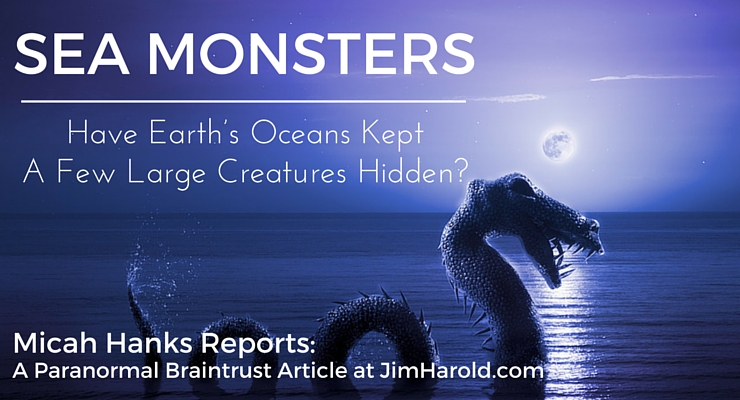

Micah Hanks
Space is, as famously uttered at the outset of each classic Star Trek adventure, the “final frontier.” Yet, despite our fascination with what alien realms may await off our terrestrial home, many would argue that new discoveries of equal magnitude—and strangeness—are likely to exist within the ocean depths.
The notion of “sea monsters” is one that has long been with us. The famous treatise of ancient Norway known as the Konungs skuggsjá, or “King’s Mirror,” dates back to around 1250; in it, one will find the following fanciful account of one of the most well-known among mythical monsters of the sea, the kraken:
“I can say nothing definite as to its length in ells, for on those occasions when men have seen it, it has appeared more like an island than a fish… It is said, that when these fishes want something to eat, they are in the habit of giving forth a violent belch, which brings up so much food that all sorts of fish in the neighborhood, both large and small, will rush up in the hope of getting nourishment and good fare. Meanwhile the monster keeps it mouth open, and inasmuch as its opening is about as wide as a sound or fjord, the fishes cannot help crowding in in great numbers. But as soon as its mouth and belly are full, the monster closes its mouth and thus catches and shuts in all the fishes that just previously had rushed in eagerly to seek food.”
The monster described above, though often compared with modern giant squid, may likely have been inspired by sightings of other creatures well-known today, namely humpback whales and other cetacean species. However, there have been other rumors of “monster” sightings over the decades which, taken by many as purely the mythic sort, may yet beg further attention.
In 2011, the words of paleontologist Dr Darren Naish of the University of Portsmouth made headlines, after he commented on the “huge number” of alleged sea monster reports collected over the years. “Sightings now on record can’t all be explained away as mistakes, sightings of known animals or hoaxes,’ Naish was quoted saying in the Daily Mail.
Naish is not alone in his theory of possible monsters that remain undiscovered in Earth’s oceans. “There is a good chance that some pretty large animals remain undiscovered in deep oceans,” says Gustave Paulay of the Florida Museum of Natural History, as quoted by Hamilton Norton in a Gawker article from 2014. “Large invertebrates are commonly found of course, but few are giant squid sized,” Paulay added. “I would think that large fish could remain undiscovered; the megamouth shark was a good example of that a couple of decades ago.”
Stanford Professor of Marine Sciences Stephen Palumbi further noted that, “The deep ocean is the biggest life zone in the known Universe. For a rare animal, it may still be possible we have not run into it yet. If it never washes up – if it never gets counted in gut contents – and if it avoids fishing nets and submarines – we maybe haven’t seen it yet.”
Those cited above certainly make a good case for how certain water monsters might exist, and remain unseen, in locations like the deeper ocean extremities. In equal measure, there are those who maintain that no such creatures could possibly exist, without marine scientists and paleontologists having to rethink our general understanding of the fossil record.
In midst of the fracas surrounding questions over the existence of such beasts, there are the handful of qualified naturalists who have weighed in with their own sightings; observations which have left them convinced that as-yet mysterious animals do populate desolate watery spots around the globe. Such had been the case in 1959, when British naturalist Dr. Denys Tucker visited Scotland on holiday and, during a short stay at Loch Ness, observed a strange, long-necked animal swimming in the Loch’s waters. A letter to New Scientist would soon follow, recounting his experience, and paired with new conviction that an Elasmosaurus—an aquatic dinosaur believed to have been extinct for 80 million years—had been the animal he observed.
“I am quite satisfied that we have in Loch Ness one of the most exciting and important findings of British zoology today,” Tucker said emphatically. The bold proposition was, of course, met with certain skepticism by his colleagues at the Natural History Museum, with many today supposing it resulted in a heated discourse that ultimately led to Tucker’s dismissal. All this, despite once being held to be among Britain’s very finest, and most qualified naturalists.
Of course, if it wasn’t one of the many “cranks and weirdos” assumed to be the sole witnesses to such uncanny things of our natural world, our most skeptical academicians make certain that, in the end, the specialists who share such experiences are relegated to the same batch of credulous “believers.”
Another sighting of a mystery marine monster comes to us from 1905, somewhere fifteen miles offshore in Brazil’s coastal waters. On the morning of December 7, scientists Edmund Meade-Waldo and Michael Nicoll, each Fellows of the Zoological Society of London, were at sea aboard the research vessel Valhalla when they observed a most unique creature swimming a short distance away; Meade-Waldo inscribed in his log the following description:
“I saw a large fin or frill sticking out of the water, dark seaweed-brown in color, somewhat crinkled at the edge. It was apparently about 6 feet in length, and projected from 18 inches to 2 feet from the water.”
Each of the men observed the creature, which soon displayed a long neck protruding from the water ahead of the fin. Setting his binoculars to work, Meade-Waldo focused on the long-necked creature, which he estimated to be, ”about the thickness of a slight man’s body, and from 7 to 8 feet was out of the water; head and neck were all about the same thickness.”
The men described a saurian face upon the creature, resembling that of a tortoise, moving its head and neck back and forth in a peculiar manner as the creature propelled itself against the waves. The coloration was dark brown, with the exception of a light, almost white coloration on the underside of the neck, similar to that of some snake species.
After watching the creature for several moments, it thrust its head below the water again, during which the pair of scientists continued to observe “a very large brownish-black patch, but could not make out the shape of the creature.”
“This creature was an example, I consider, of what has been so often reported, for want of a better name, as the ‘great sea-serpent’,” Nicoll wrote of the impressive animal.
A very similar creature, to the point of displaying nearly identical coloration and features, was seen by the crew aboard the sailing vessel HMS Daedalus several years earlier in 1848. This animal, which purportedly bore a mass of hair (or possibly seaweed, as suggested by Daedalus Captain McQuhae, the principle observer), was later surmised by Meade-Waldo as possibly having been the same variety of animal he and his colleague Nicoll observed more than half a century later. Of equal intrigue had been Mr. Nicoll’s assessment that the creature’s appearance suggested, to his discerning eye, that the “serpent” had in fact been some form of mammal. “It is of course, impossible to be certain of this, but the general appearance of the creature, especially the soft, almost rubber-like fin, gave one this impression.”
Skeptics are often quick to dismiss such reports; it had been no less an authority of such prehistoric matters than Sir Richard Owen had, at the time of the Daedalus encounter, assured the public that the creature had merely been a sea lion set adrift on a large piece of ice. More recently, evolutionary biologist Gary J. Galbreath wrote in Skeptical Inquirer that the creature— despite the “lizard-like” appearance described by those who had seen it at close range—had merely been a sei baleen whale, skimming the surface of the ocean as it enjoyed its afternoon meal.
However, few similar rebuttals have been offered of the Meade-Waldo and Nicoll observation. With each of the men having been seasoned naturalists, it would seem unusual indeed that a sudden, curious failing memory might beset them both; or at very least, a sudden, gross inability to properly assess the appearance of some known animal species.
Do mysterious beasts the likes of our mythical “sea serpent” truly populate the ocean depths, and if so, how might their discovery have eluded us for so long? While this enduring problem will remain mysterious, for now, we are nonetheless left to recognize that, of all places where unusual earthly lifeforms may exist, the oceans remain the most promising. There may yet be a few surprises to uncover… and maybe even a few big ones.
—
Micah Hanks is a writer, podcaster, and researcher whose interests include history, science, current events, cultural studies, technology, business, philosophy, unexplained phenomena, and ways the future of humankind may be influenced by science and innovation in the coming decades. With his writing, he has covered topics that include controversial themes such as artificial intelligence, government surveillance, unconventional aviation technologies, and the broadening of human knowledge through the reach of the Internet. Micah lives in the heart of Appalachia near Asheville, North Carolina, where he makes a living as a writer and musician. You can find his podcasts at GralienReport.com and his books at Amazon.com
